► Ford S-Max 2.0 TDCi long-term test review
► Practical like a skip, but much better to drive
► Read Mark Walton’s daily driver diary
Month 11 running a Ford S-Max: the conclusion to our long-term review
And so our time with the Ford S-Max comes to an end, and frankly I’ve almost forgotten it already. That sounds harsh, I know. I mean, if I said that about a person, it would be harsh – ‘my aunty died last week but for the life of me I can’t remember her name’. But to say that about a car isn’t necessarily a criticism, if the car in question enjoys a purely functional role in your life.
Put it this way: if your dishwasher broke tomorrow and you replaced it with a new one, would you really reflect on your old dishwasher, a week down the line? Would you think about it, all sad and lonely on the scrap heap, and plan a rescue mission to bring that poor little white box back into the warm, loving bosom of your family home?
Nope.
That coldness you feel has nothing to do with the effectiveness of your old dishwasher, its ability to wash your dishes, or its length of service. You might have owned that machine for 30 years, you’d still replace it with a shiny new one like a cold, selfish sociopath. Because you have no emotional tie to it.
And that’s the thing about the S-Max: CAR has been running it for almost year, it’s been my daily runabout for six months, yet in that time I haven’t developed any bond with this car at all. No ties, no friendship, no love. It’s practical, roomy, luxurious in many ways; but I’ve always driven it almost absent-mindedly, with all the emotional investment of a trip to the barbers.
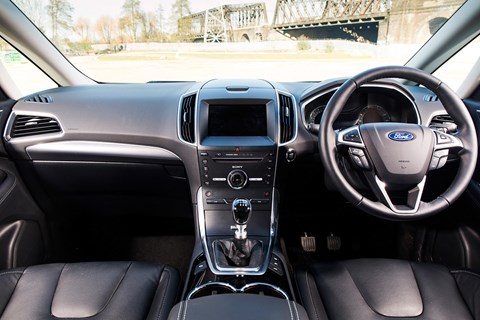
‘Come on, Mark!’ I hear you cry. ‘There must be something positive you can say about this £36,000 luxury car!’ Of course: it rides brilliantly on those tall-profile tyres and it cruises beautifully on long motorway journeys. The interior is always comfortable, and while the back row is a little tight on space, if you only use the folding seats occasionally you’re granted an enormous boot the rest of the time. The equipment level on our Titanium spec car was high: a big panoramic roof, the latest eight-inch touchscreen that’s intuitive to use. Great sound system, rain-sensing wipers and clever automatic headlights (which mask off oncoming traffic from the full beam, while leaving your wider view brightly lit).
All of these things make the S-Max admirable, but only because of its functionality. But in terms of an emotional repsonse? It’s not a pretty car, because there’s just no disguising that kind of massive bulk; the driving position is upright, a place of work not leisure, and while everything you touch has a feel of quality, it’s never an exciting thing to drive. Our car had the 178bhp four-cylinder turbodiesel engine, which is spirited enough, and the six-speed manual is swift and loose-feeling. In fact, the body control is pretty good too, good enough for you to punt it along a back road if you’re in the mood, and there are no kids in the back to complain… but you only do that for two or three corners before coming to your senses: ‘Really? You want to do this? In a people carrier?’ Which ruins the moment.
And that’s the killer blow for the S-Max: your perception of yourself. Yes, this car may be moderately less frumpy than its boxy sibling, the Galaxy, but that’s like saying cod-liver oil is moderately tastier than pond scum. It may have a curvy roof, but the S-Max is no fastback. It’s a car that’s loaded with meaning, because if you need seven seats you no longer have to choose a big family box, you could buy an SUV, with pretensions (yes, I know they’re pretensions) for adventure. Choosing an S-Max, as a public statement, is a surrender.
Don’t get me wrong – I’m a happy dad, I’ve got four kids, I accept, I’m middle aged; rejection of the S-Max isn’t a mid-life crisis. (My suggestion, a couple of issues ago, that I might swap it for a red Mustang convertible, was just playful.) But driving the S-Max, especially if I was on my own, made me want to shoot myself.
So our Ford ran faultlessly, it was brilliantly helpful and practical – over the months it lugged kids, dogs, furniture, shopping and a copper hot-water tank in the back. The highlight was definitely my trip to Le Mans in the summer, when I used it as a camper van. But I could heap similar praise on my dishwasher. Though I’ve never slept inside it, I did once write a poem dedicated to its loyal service. It went:
Oh dishwasher, oh dishwasher,
oh dishy dishy,
The only sound you ever make,
As you humbly clean our breakfast plates
Is ‘Swishy-swishy. Swishy-swishy’
I never wrote a poem about the S-Max.
Logbook: Ford S-Max 2.0 TDCi Titanium
Engine 1997cc 16v turbodiesel 4-cyl, 178bhp @ 3500rpm, 295lb ft @ 2000-2500rpm
Gearbox 6-speed manual, front-wheel drive
Stats 9.7sec 0-62mph, 131mph, 129g/km CO2
Price £28,845 As tested £36,270
Miles this month 1221 Total miles 10,819
Our mpg 35.9 Official mpg 56.5
Fuel this month £197.00 Extra costs £0
Count the cost:
- Cost new £36,270 (including £7,425 of options)
- Dealer sale price £24,435
- Private sale price £23,120
- Part-exchange price £22,135
- Cost per mile 11p
- Cost per mile including depreciation £1.53
By Mark Walton
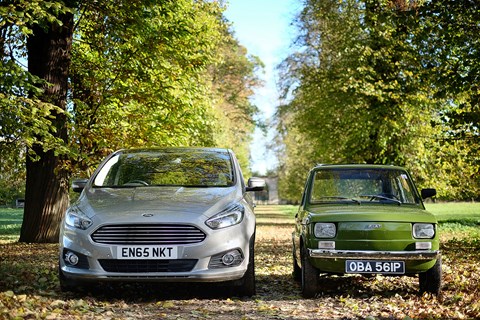
Month 10 running a Ford S-Max: little vs large
Those who read my story about importing a Fiat 126 a couple of issues ago will be pleased to hear it’s passed its MOT and is now registered in the UK. This means I have a stark choice for my commute in the mornings: little vs large; fast vs slow; Radio 4 vs a lawnmower engine droning in your ear. The S-Max should be the obvious choice, but the Fiat exposes the Ford’s biggest weakness as an everyday car – it’s like driving an aircraft carrier.
Logbook: Ford S-Max 2.0 TDCi Titanium
Engine 1997cc 16v turbodiesel 4-cyl, 178bhp @ 3500rpm, 295lb ft @ 2000-2500rpm
Gearbox 6-speed manual, front-wheel drive
Stats 9.7sec 0-62mph, 131mph, 129g/km CO2
Price £28,845 As tested £36,270
Miles this month 986 Total miles 9598
Our mpg 35.9 Official mpg 56.5
Fuel this month £112.98 Extra costs £0
By Mark Walton
Month 9 running a Ford S-Max: not an Uber, yet
Uber, the app-based taxi service, hasn’t reached Lincolnshire yet, but I’ve been thinking of signing up, earning a bit on the side. I’ve had plenty of practice – with two teenage boys at home, me and the S-Max get to play ‘cabbies’ nearly every weekend.

Of course, the Ford does the job brilliantly, quickly converting from a five-seater with a cavernous boot to a decent seven-seater – there isn’t loads of legroom in the back row for a beanpole teen, but enough for a lift home from the O2 at midnight.
Logbook: Ford S-Max 2.0 TDCi Titanium
Engine 1997cc 16v turbodiesel 4-cyl, 178bhp @ 3500rpm, 295lb ft @ 2000-2500rpm
Gearbox 6-speed manual, front-wheel drive
Stats 9.7sec 0-62mph, 131mph, 129g/km
Price £28,845
As tested £36,270
Miles this month 961
Total miles 8612
Our mpg 35.9
Official mpg 56.5
Fuel this month £136
Extra costs £0
By Mark Walton
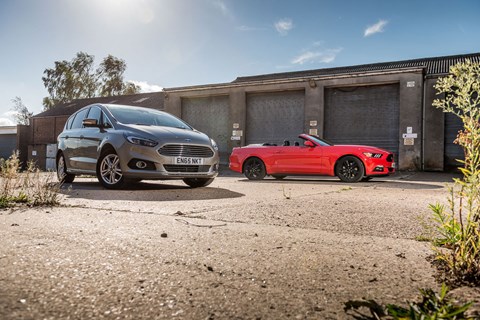
Month 8 running a Ford S-Max: S-Max vs v-max – the meaning of (mid)life
These two cars have absolutely nothing in common, apart from the blue oval they wear on the nose. For instance, the Ford S-Max is 4796mm long, whereas the Mustang is 4784mm long. See? Twelve millimetres of different.
The S-Max has a turbo four-cylinder, whereas the Ecoboost Mustang has a four-cylinder turbo. This high-spec S-Max costs £36,270, while a base Mustang convertible costs a wholly dissimilar £36,745.
And yet, despite these massive differences, I want to know: if you were going through a mid-life crisis and you fancied a new start, a new wardrobe, a new Thai wife and perhaps a bright red convertible, could you trade your frumpy people carrier in for the new Mustang soft-top? Seriously, what’s the worst that could happen?
I guess your teenagers might hate you. Weirdly, my kids found the cramped rear buckets in the Mustang almost as comfortable as the short, bolt upright middle seats of the densely packaged S-Max, despite having their ankles mangled. Also weirdly, they thought their old man driving a Mustang was rather cool, instead of pitiable as I expected.
Equally surprising is the ride and handling – the S-Max feels tighter and almost as agile as the disturbingly wobbly Mustang, which feels lazy in the corners and lumpy over potholes. The Mustang has a Sport mode to play with, hilariously represented by a little race helmet icon (yeh! Right! It’s a track car! Sure! Whatever!). This stiffens things up, but nothing can disguise the bulk and weight of this big barge.
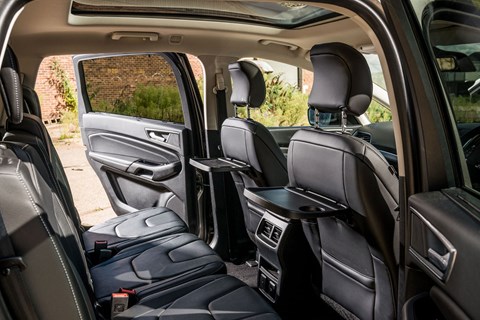
The Mustang certainly has raw speed on its side, as you’d expect, with 312bhp pumping out of this 2.3-litre engine (the S-Max produces just 178bhp). But there’s something about the slightly strained sound of the Mustang and the jerky auto box that means you’d never say it was a muscle car, and the torquey S-Max is no slouch. So, they’re practically interchangeable then.
And what the big red convertible has that the S-Max lacks completely is star quality. Our beige-grey people carrier is the perfect way to blend in, while the Mustang is like riding through town on a circus elephant. People turn and stare and smile, and if you have the roof down pedestrians talk to you while you’re waiting in traffic. And despite the cynicism you might be feeling, despite its ludicrous proportions and wannabe muscle-car pretensions, this is a very hard car to dislike on a warm summer’s day. Top down, arm on the window, cruising along, the Mustang is undeniably a feel-good car.
So while in some ways the Mustang actually proves how good the ultra-modern S-Max is, in other ways it just highlights what your automotive life lacks, when you’re in the kid-carrier, sensible-dad stage of life.
My advice is, just do it. If you’re having a midlife crisis, don’t ask permission, don’t even discuss it at home. Just go into your Ford dealership tomorrow and drive home a bright red Mustang convertible. What’s the worst that could happen?
By Mark Walton
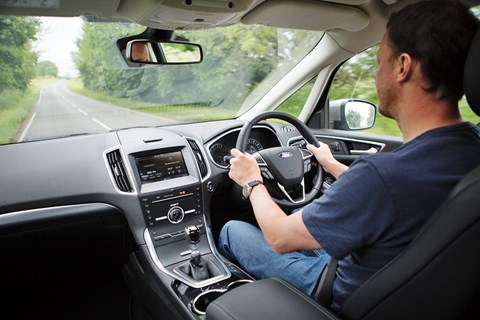
Month 7 running a Ford S-Max: the Sync2 infotainment system
Back in 2011 I ran a Ford C-Max long-termer, and then I had a Focus ST in 2013. Both had identical sat-nav and sound systems, the standard Ford spec that hadn’t changed for years.
I said then that Ford had fallen behind, but our S-Max has the latest ‘Sync2’, and it’s leapfrogged ahead again.
The 8in touchscreen is divided into quarters for nav, climate, phone and entertainment, and it’s quick and intuitive to use.
Trouble is, the speed things change, how long before it’s out of date? January?
Logbook: Ford S-Max 2.0 TDCI Titanium
Engine: 1997cc 16v turbodiesel 4-cyl, 178bhp @ 3500rpm, 295lb ft @ 2000-2500rpm
Gearbox: 6-speed manual, front-wheel drive
Stats: 9.7sec 0-62mph, 131mph, 129g/km
Price: £28,845
As tested: £36,270
Miles this month: 1459
Total miles: 6588
Our mpg: 36.6
Official mpg: 56.5
Fuel this month: £184
Extra costs: £0
By Mark Walton
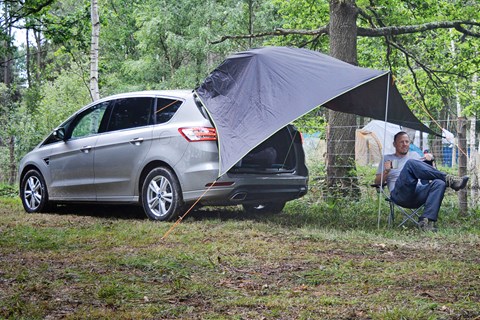
Month 6 running a Ford S-Max 2.0 TDCi: go to Le Mans – and pack heavy
As Beyoncé once said, if life serves you lemons, you might as well make lemonade. Not that our Ford S-Max is a lemon – not in car terms. It’s not a peach either; probably more like a watermelon. A great, big watermelon – cumbersome, heavy, pleasant enough to eat when you slice it up, but not terrifically flavoursome either, truth be told. I mean, you don’t get watermelon-flavoured jam or yoghurts, do you? And the big seeds are annoying…
How did we get onto watermelons? Oh yes. What the philosopher Beyoncé meant, of course, is that you might as well make the most of what you’ve got; and while a 4.8-metre-long, 7-seater watermelon might not be the most exciting car in the world, it has its advantages. Like, you can use it as a camper van at Le Mans. See? Lemonade.
And what a year to drive a Ford to Le Mans: on the 50th anniversary of the GT40’s legendary 1966 win, the Blue Oval was back in the 24-hour race with its new GT, taking on the Ferraris, Porsches and Astons in the ‘LMGTE Pro’ category. I can’t think of a better way to celebrate, than driving a in ‘Nursing Home Beige’ people carrier down to the race.
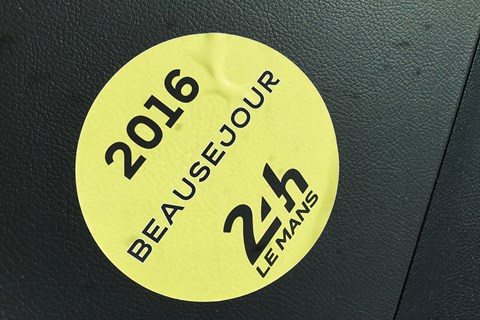
It’s years since I last went to Le Mans, but there were a few things I remembered before setting off: the journey is always fun, with thousands of Brits heading in the same direction; it takes no time to get there (about four hours from Calais); and it always rains. Always. Which means proper camping equipment is essential – forget your £12.99 pop-up tent, you might as well sleep under a tea towel for the weekend.
That’s why my enormous MPV (or ‘LMCV Pro’ as I decided to christen it – ‘Le Mans Camping Vehicle’) makes so much sense. With the middle and third rows of seats folded down, the huge, uninterrupted load bay measures two full metres from the inside of the boot hatch to the back of the driver’s seat – a totally flat, 6ft 6in-long double bed. And with our optional (£750) panoramic roof, the headroom is 93cm from the folded-down floor to the glass ceiling – enough for a grown man like me to sit up straight. Throw in an inflatable camping mat and a sleeping bag, and no matter how the heavens poured, I was going to be snug (and smug).
And the heavens certainly did pour: torrential rain on the Thursday and Friday meant by the time we arrived early Friday evening our infield campsite was half flooded, half ploughed. Fortunately the organisers had opened a couple of reserve areas, including one by a small pond that was relatively dry and firm. It was a long walk to the (rank) portaloos, but otherwise we got lucky. Most campsites aren’t this picturesque.

And so, as everyone else struggled to put up their tents, I set up a simple tarp over the rear hatch to provide a bit of outside cover, and boiled a nice cup of tea to mark our arrival.
Spending the weekend at Le Mans is as much about the atmosphere in the sprawling campsites as it is about watching the race. Our camp, Beausejour, is one of the biggest but it’s also one of the furthest away from the main grandstand complex. It’s connected to the circuit entrance up near Maison Blanche by a little hop-on-hop-off ‘road train’, but even so, you have to be prepared to do a lot of walking at Le Mans. For that reason we decide to stay local on the Friday night, eating from a campsite hot-dog stand before heading to bed.
It’s a raucous first night. Fans come from all over the world, and the mood is carefree and drunken, bordering on feral; like a Scout camp crossed with a medieval Viking festival. Bare-chested men chop trees and light fires; fireworks boom and flash through the woods; and until 3am there are shouts and screams ringing through the darkness. Eventually, silence falls… apart from the constant drone of the camping generators. If human civilisation collapsed after a global catastrophe, the aftermath would probably resemble a Le Mans campsite.

Which is why the S-Max feels like such a safe haven: my sleeping bag is up off the wet earth; rain patters harmlessly on4 the glass roof all night; the madness outside is sound-proofed; and I feel safe and secure in my metal pod. Interior lighting? No problem. Phone charger? It’s right there. Our car is fitted with the optional Family Pack (£400), which means blinds for the rear windows and a three-pin plug. The only hitch comes when I want a pee in the middle of the night – as soon as I open a door, the auto-lighting switches on the headlights and all the interior lights. I feel like a semi-naked burglar caught in a searchlight.
Next day, after a camping-stove bacon sandwich, we head out. Our camping pitch cost around £50 (depending on exchange rate) and while you can watch the race from some grass banking within the Beausejour camp, no-one’s going to spend 24 hours there; which means paying around £50 more for a general entrance weekend ticket. This gives you access to the trackside areas, including the concrete terraces on the pit straight (grandstand seats are extra).

We head to that canyon of grandstands for the start, but the terraces are already packed with people, so we walk further, to the far side of the Dunlop Bridge, and watch the start from the Esses. After a slow safety-car start, it soon develops into a fascinating race, with Mike Conway in the Toyota taking an early lead. Of course, we all know how Toyota’s race turns out in the end…
Meanwhile, we wander to the next corner, Tertre Rouge, and as the sun comes out we have a beer and an afternoon snooze on the banking. This is typical Le Mans – describe it to anyone who’s never been, and they may wonder what the appeal is. You’re lying there, a little uncomfortable, on damp grass, on a banking so packed with people you have to step over bodies to find a space, watching cars through a distant wire fencing… I can’t deny, sometimes even I dream of sitting at home and watching it on TV. But as the afternoon turns to evening and darkness falls, the atmosphere lifts again, the headlights come on, and you feel you’re taking part in something enormous and exciting – like a music festival crossed with a war.
After a late-night ride on the ferris wheel we bail out of the traditional all-nighter and I end up back in my S-Max at 1am. With the window cracked open an inch, I drift into blissful sleep to the drone of the cars on the nearby track… seriously, the S-Max makes a great camper van.
It’s always strange, waking up at Le Mans and realising the cars are still pounding round. That’s when 24 hours starts to feel like a really long race.
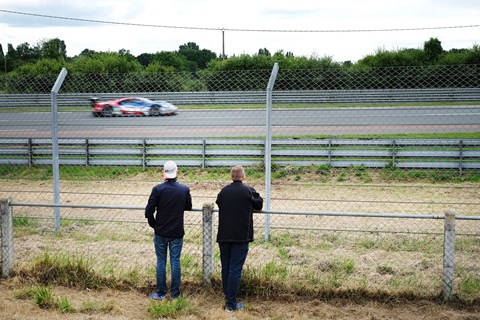
Striking camp takes barely any longer than it took to set up – we just chuck everything into that cavernous boot – and we’re soon trackside once again. After watching the bizarre finish from the banking at the Porsche Curves (when Toyota lose it on the final lap), we watch the victorious Ford GT go by, and then leg it back to the car. We get out of the campsite and out of town before the traffic jams up, and by early evening we’re home.
And our flabby, family S-Max had gone up a notch in our estimations. Now it’s got me thinking: ‘Where next?’
From the driving seat
+ Compliant ride
+ The captain’s armchair, visibility, interior equipment all great for a long-distance journey
– All-new S Max feels bigger and heavier than the original
– Feels more like a big bus
Logbook: Ford S-Max 2.0 TDCi Titanium
Engine: 1997cc 16v turbodiesel 4-cyl, 178bhp @ 3500rpm, 295lb ft @ 2000-2500rpm
Transmission: 6-speed manual, front-wheel drive
Stats: 9.7sec 0-62mph, 131mph, 129g/km
Price: £28,845 As tested £36,270
Miles this month: 1471
Total miles: 5129
Our mpg: 36.6
Official mpg: 56.5
Fuel this month: £198
Extra costs: £0
By Mark Walton

Month 5 running a Ford S-Max 2.0 TDCi: a change of player
So that’s a bit of a shock to the system, isn’t it? One minute I’m an invincible Lord of the Road, a never-gonna-grow-up boy racer in my Subaru WRX. Next minute, this… a minibus, covered in Anthony ffrench-Constant’s dog hair (well, not his dog hair. It’s his dog’s dog hair, right?).
Ah well, the S-Max has its advantages: like fuel economy better than 20mpg, amazing long-distance comfort, and an absolutely cavern-like interior space. Over the coming months I need to think of some interesting things that might fill it. Maybe I need to get a dog?
Logbook: Ford S-Max 2.0 TDCi Titanium
Engine 1997cc turbodiesel 4-cyl, 178bhp @ 3500rpm, 295lb ft @ 2000rpm
Transmission 6-spd manual, fwd
Stats 9.7sec 0-62mph, 131mph, 129g/km CO2
Price £28,845
As tested £36,270
Miles this month 828
Total 3658
Our mpg 37.6
Official mpg 56.5
Fuel £116
Extra costs £0
By Mark Walton
Month 4 running a Ford S-Max 2.0 TDCi: who wears the test trousers?
This magazine was recently inundated by a letter from A Disgruntled-Reader suggesting that my regular references to the missus’s opinions on the S-Max were somewhat superfluous to requirements.
May I, gently, beg to differ? In this house, our long-termer fulfils the daily role of family transport. And this means that, whilst I’m here chopping away at the keyboard like a myopic sushi chef, the missus is pinging all over the countryside in the S-Max; a remarkably accurate, large-scale demonstration of Brownian motion.
This, in turn, means that her insights on day-to-day life aboard the Ford must, inevitably, carry weight for those family-shackled readers contemplating ownership. As would those of up to six assorted school-run hooligans, were they not invariably rather more interested in the thornier issues of life, such as how much deeper the ocean would be without sponges…
Indeed, were its on-board lexicon not confined to the haphazard slither of fur, the frantic scrabble of toenails and the less than covert breaking of wind, you’d probably be hearing a lot more of what the evil-smelling dog thinks to boot.
Be that as it may, my all too brief tenure of the S-Max has come to an end, and I feel sure Mark Walton will henceforth redress any perceived imbalance in perspective with appropriate tales of two-wheel teetering and general derring-do.
For myself, I consistently miss the exceptional comfort of the Ford’s front seats. Despite their somewhat upright stance they contrive to cosset as snugly as if I had just backed into a huge mound of unbaked bread dough. This closeness of fit improves no end the efficacy of the seat heating, which we have taken to rather more willingly than the steering wheel rim heater, accurately billed by the missus (sorry) as ‘too effing hot’.
Neither should praise be reserved for the front seats alone. We all miss not merely the space, comfort and visibility afforded by even the third seating tier, but also the ease of system operation in sliding and flopping seats to and fro. Make a third row this easy to access and, rather than endure the jostle and bicker of three abreast amidships when confronted with a five-up journey, most youngsters will opt for stern occupancy.
Gripes are slight. But I do bemoan the absence of a digital speedometer readout option on the driver’s instrument binnacle screen. The diversity of information herein isn’t as rich as you might hope, and I already know, for instance, what radio station I’m trying to listen to over the din emanating from the back.
From the driving seat
+ Outstandingly well thought out seating flexibility
+ Terrific long-haul comfort
– Nowhere to store the retractable luggage cover on board
– Needs a digital speedometer readout
Logbook: Ford S-Max 2.0 TDCI Titanium
Engine 1997cc 16v turbodiesel 4-cyl, 178bhp @ 3500rpm, 295lb ft @ 2000-2500rpm
Transmission 6-speed manual, front-wheel drive
Stats 9.7 sec 0-62mph, 131mph, 129g/km
Price £28,845
As tested £36,270
Miles this month 941
Total miles 2830
Our mpg 37.6
Official mpg 56.5
Fuel this month £123.04
Extra costs £0
By Anthony ffrench-Constant

Month 3 running a Ford S-Max 2.0 TDCi: changing perceptions
Bristling with blue oval prejudice levels I’d presumed long buried, a friend of the missus recently climbed reluctantly out of her Mercedes map-spanker and into the front of the S-Max…‘Ooh, this is comfortable,’ she immediately remarked; high praise indeed from one used to sitting out 300 miles at a stretch and remaining ready for more than just a quick cup of tea and a nice lie down.
Such a pity, then, that such carefully crafted comfort is so painfully marred by a consistent centre-console box lid ‘clonk’ that requires gearchange elbow re-education.
By Anthony ffrench-Constant
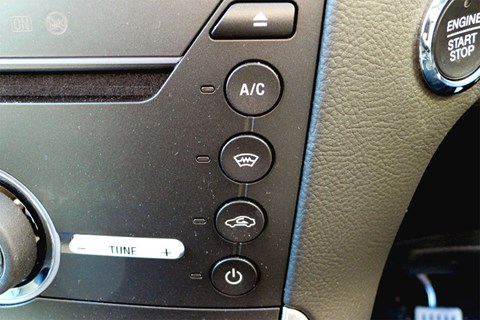
Month 2 running a Ford S-Max 2.0 TDCi: quick-clear windscreen, more leisurely side windows
There can’t – courtesy of a heated windscreen – be many better machines for getting the school run rolling in a hurry on a frozen Mudfordshire morning than an S-Max.
Trouble is, the missus points out, that the alacrity with which the front and rear screens clear merely highlights the propensity of the side glazing to dither. Lowering the windows fails to bring them into sufficient contact with the rubber seals to effect scrapage, so a good few minutes can elapse before they offer any greater transparency than the average shower curtain.
Logbook:
Price £28,845
As tested £36,270
Miles this month 1011
Total miles 1889
Our mpg 37.3
Official mpg 56.5
Fuel this month £121.631
Extra costs £0
By Anthony ffrench-Constant
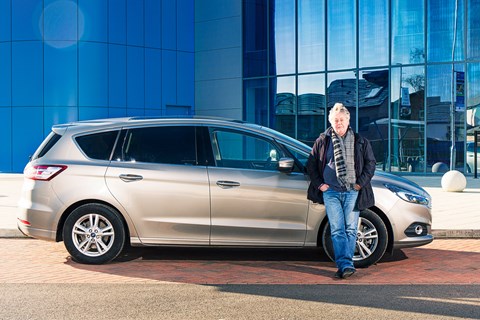
Month 1 running a Ford S-Max: the introduction to our long-term test review
I cannot tell you what an unalloyed joy it is to once again climb aboard a car which favours ergonomic excellence and true practicality over architectural whimsy and wanton quirk. But I’ll give it a shot.
Within next-generation couture now merely good rather than first-generation great-looking, the S-Max plays the seven-card trick with artful insouciance. The front seats are properly comfortable and the driving position would be perfect but for a fraction less wheel-reach adjustment than I’d like, and a centre console box lid that obstructs the elbow when changing gear.
Seat rows are stadium-tiered to maximise visibility for every occupant, middle-row seats tilt and slide to give fuss-free access to terrorist class, and all five rear seats may be independently flattened via a phalanx of one-touch, loadspace-wall-mounted buttons. Oh, and, an externally mounted, full-sized spare wheel merits applause.
Everyone’s happy: the missus no longer complains of ‘Cactarse’ after every journey, the hooligans relish fully opening windows and – a part of the £400 optional ‘Titanium Family Pack’ – tray tables they may flap up and down to our heart’s discontent, and even the evil-smelling dog has acres more room in which to gently reek astern.
As ever, we went to some lengths to minimise option spending on a car already costing a whisker short of 29 grand. And, as ever, we seem to have failed; this Titanium specification machine boasting some £7425 worth of additional kit.
Whilst I’m happy to swing for some of this (‘Metalicious’ paint, adaptive LED headlights, panoramic sunroof, Sony multimedia system upgrade, heated seats and helm, Family Pack…), I’m pretty sure that a veritable raft of stowaway safety technology has also made it up the gangplank.
No matter, because the one system we never, ever wish to employ – the standard fit Lane Keeping Aid – may be switched off, and doesn’t irritatingly reboot every time the car is started in the manner of some specimens we’ve recently encountered.
With Ford’s new 207bhp, 2.0-litre biturbo diesel not yet available, the revised 178bhp, 2.0-litre turbodiesel remains the weapon of choice. And, but for a missus-identified reluctance to pull away from junctions in second gear, entirely satisfactory it is too. A sweet-actioned six-speed manual transmission is also notably easy to live with, though I shouldn’t mind a slightly longer gear lever to suggest my elbow clear of that annoying centre-console box lid.
The S-Max shares the Mondeo’s MacPherson strut front and ‘integral link’ rear suspension, and, on 17in alloys chosen to offer a respectable tyre wall height, it’s really very good indeed; firm enough to offer fine body control and plenty of grip, yet always pliant with a consistently sophisticated attitude to bump absorption. A new active steering option, which crams electric motor and gearing system within the wheel boss, didn’t make the cut either. The standard system is nicely weighted, accurate and a respectable foil to that superior suspension.
Though it’s currently averaging nearly 20mpg less than my C4 Cactus (we hope that matter may improve as mileage rises), we’re entirely enamoured with the S-Max. Not only is it a pleasing space within which to travel, it also remains the most engaging drive in its disparate seven-seat segment.
How we specified ours
- Titanium X Pack: an expensive way to acquire adaptive LED headlights and leather upholstery
- Titanium Family Pack: an inexpensive way to acquire easy fold rear seats, tray tables, sunblinds and power outlet
- Self-Levelling Suspension: not asked for, but essential, given the load carrying capacity of this executive omnibus
- Panorama Roof: adds much needed light to an interior suffering from a higher waistline than before
- Front and Rear View Camera: haven’t used the front, and rear filthy dirty since day one; needs auto
Logbook: Ford S-Max 2.0 TDCI Titanium
Engine 1997cc 16v turbodiesel 4-cylinder, 178bhp @ 3500rpm, 295lb ft @ 2000-2500rpm
Transmission 6-speed manual, front-wheel drive
Stats 9.7sec 0-62mph, 131mph, 129g/km
Price £28,845
As tested £36,270
Miles this month 740
Total miles 878
Our mpg 35.5
Official mpg 56.5
Fuel this month £117.57
Extra costs £0
By Anthony ffrench-Constant
Read more Ford reviews